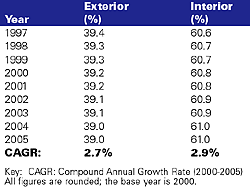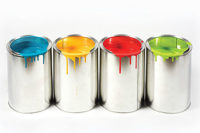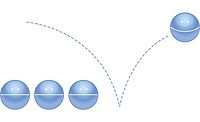Coating the Blues of the Architectural Market with Challenges


Few paint makers are taking solace in the fact that the architectural paint market is somewhat recession-proof because remodeling occurs even when the economy turns sour. Paint companies have been able to abide by the 1999 National Rule for Architectural Coatings from the EPA. However, they are seeing stricter air quality standards from the South Coast Air Quality Management District (SCAQMD) and shuddering at their potential adoption by the Ozone Transport Commission (OTC), which regulates air pollution limits for the Northeast and Mid-Atlantic states. Many coating manufacturers who may be considering expanding into new markets are having second thoughts about undergoing more reformulation, developing new compliant labels, and dealing with other regulations, such as waste disposal.

While some independents are doing well in the face of such competition, others are not. Opinions vary as to why this is so, but a major red flag remains atop the flagpole - independent dealers lack the financial clout they need. These dealers attempt to court both serious do-it-yourselfers (DIYers) as well as professional contractors by providing them with good service support. For many such dealers, it's not working effectively enough. For one thing, well-staffed and well-financed stores, such as those owned by Sherwin-Williams, are doing a great job in servicing the professional market. Home centers, such as The Home Depot, on the other hand, are not only expanding the number of outlets but are also devoting more attention to DIYers as well as charging them the same price for paint that contractors would pay.

Increasing consolidation in the paint industry is posing a challenge for paint retailers by providing fewer choices for them in the marketplace. An independent paint dealer, for example, may be faced with discontinuance of a popular local paint brand because the small paint firm can no longer compete-forcing the dealer to promote a lesser-known brand. These dealers are further challenged into aligning themselves with smaller but more aggressive paint companies, trying to differentiate themselves from sellers of national brands. Consolidation also poses a major problem for smaller paint firms that are not already strongly entrenched in niche markets. Larger, consolidated firms can negotiate better contracts with suppliers and more lucrative arrangements with retailers, leaving smaller paint companies struggling for survival.

Surging fuel prices are escalating the cost of the paint manufacturing process, as well as driving up the cost of transportation. When one considers that the cost of gasoline rose 21% between 1999 and 2000 and that each gallon of paint weighs an average of almost 11 lbs, it is easy to see how this is dramatically affecting freight costs. Even larger firms with strategically placed warehouses and multiple plant locations have to spend considerable time and expense in planning and consolidating plant shipments and weighing those costs against warehousing and storage expenses.
Obviously, the architectural paint market is a mature one, and the challenge is that competition will become far more intense, since carving out new, untapped markets will be difficult. Instead, any significant growth will have to come at the expense of taking market share away from others. In addition, new market entrants will be discouraged as large paint companies engage in aggressive product proliferation and price-cutting as a result of a combination of product reformulation and streamlined production.

The architectural coatings industry is a giant, and a slow-moving one at that. While it represents a market filled with challenges, it also is one filled with opportunities. It is anyone's guess how the market will shape up once it shakes off the current sluggishness of the economy. We just have to see what happens after the paint dries.
Looking for a reprint of this article?
From high-res PDFs to custom plaques, order your copy today!





